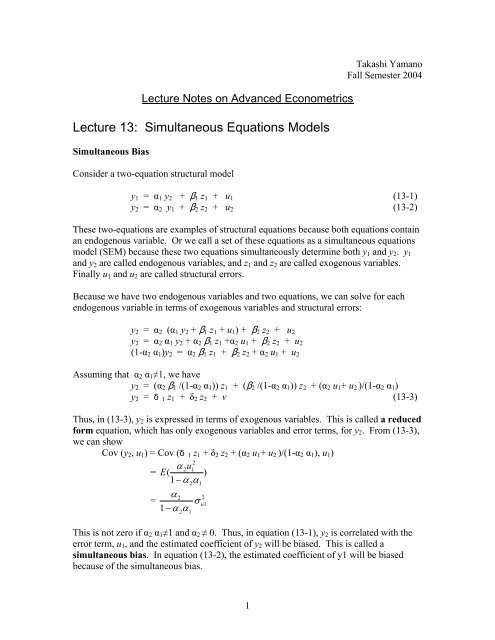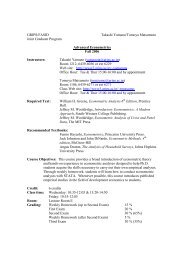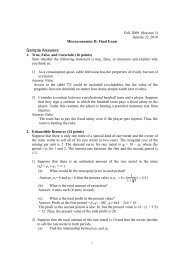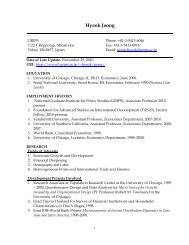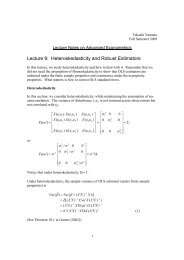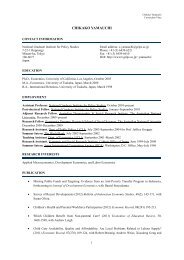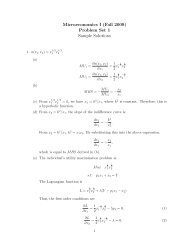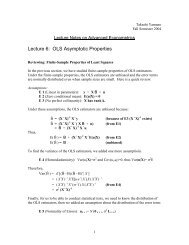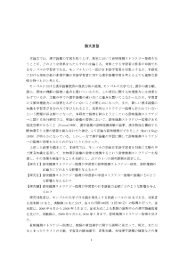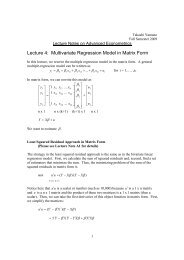Takashi Yamano
Takashi Yamano
Takashi Yamano
- No tags were found...
You also want an ePaper? Increase the reach of your titles
YUMPU automatically turns print PDFs into web optimized ePapers that Google loves.
Lecture Notes on Advanced EconometricsLecture 13: Simultaneous Equations ModelsSimultaneous BiasConsider a two-equation structural model<strong>Takashi</strong> <strong>Yamano</strong>Fall Semester 2004y 1 = α 1 y 2 + $ 1 z 1 + u 1 (13-1)y 2 = α 2 y 1 + $ 2 z 2 + u 2 (13-2)These two-equations are examples of structural equations because both equations containan endogenous variable. Or we call a set of these equations as a simultaneous equationsmodel (SEM) because these two equations simultaneously determine both y 1 and y 2 . y 1and y 2 are called endogenous variables, and z 1 and z 2 are called exogenous variables.Finally u 1 and u 2 are called structural errors.Because we have two endogenous variables and two equations, we can solve for eachendogenous variable in terms of exogenous variables and structural errors:y 2 = α 2 (α 1 y 2 + $ 1 z 1 + u 1 ) + $ 2 z 2 + u 2y 2 = α 2 α 1 y 2 + α 2 $ 1 z 1 +α 2 u 1 + $ 2 z 2 + u 2(1-α 2 α 1 )y 2 = α 2 $ 1 z 1 + $ 2 z 2 + α 2 u 1 + u 2Assuming that α 2 α 1 ≠1, we havey 2 = (α 2 $ 1 /(1-α 2 α 1 )) z 1 + ($ 2 /(1-α 2 α 1 )) z 2 + (α 2 u 1 + u 2 )/(1-α 2 α 1 )y 2 = 1 z 1 + δ 2 z 2 + v (13-3)Thus, in (13-3), y 2 is expressed in terms of exogenous variables. This is called a reducedform equation, which has only exogenous variables and error terms, for y 2 . From (13-3),we can showCov (y 2 , u 1 ) = Cov ( 1 z 1 + δ 2 z 2 + (α 2 u 1 + u 2 )/(1-α 2 α 1 ), u 1 )2α2u1= E ( )1−αα=α21−αα2212σ u 11This is not zero if α 2 α 1 ≠1 and α 2 ≠ 0. Thus, in equation (13-1), y 2 is correlated with theerror term, u 1 , and the estimated coefficient of y 2 will be biased. This is called asimultaneous bias. In equation (13-2), the estimated coefficient of y1 will be biasedbecause of the simultaneous bias.1
In this case, we can not identify either curve, because z is included in the both equations.Thus, z does not satisfy the exclusion restrictions. This is illustrated in Panel 2. Weobserve changes in price and quantity from A to C. But, because both curves can shiftfrom A to C, we can not trace curves. Both curves in Panel 2 could be steeper or flatter.Reduced Form Equations in General CasesIn general, we can have more than two simultaneous equations (more than twoendogenous variables) at once. Suppose there are 3-endogenous variables:y 1 = f 1 (y 2 , y 3 , z 1 ,z 2 , z 3 , z 4 )y 2 = f 2 (y 1 , y 3 , z 1 , z 2 , z 5 , z 6 , z 7 )y 3 = f 3 (y 1 , y 2 , z 1 , z 2 , z 8 , z 9 , z 10 )The reduced form equation for each endogenous variable will contain all of theexogenous variables:y 1 = f 1 (z 1 ,z 2 , z 3 , z 4 , z 5 , z 6 , z 7 , z 8 , z 9 , z 10 )y 2 = f 2 (z 1 ,z 2 , z 3 , z 4 , z 5 , z 6 , z 7 , z 8 , z 9 , z 10 )y 3 = f 3 (z 1 ,z 2 , z 3 , z 4 , z 5 , z 6 , z 7 , z 8 , z 9 , z 10 )From these reduced form equations, we can identify endogenous variables in thestructural from equations.Example 13-1: Inflation and Openness by using Openness.dtaSee Example 16.4 and 16.6 in Wooldridge:The Reduced Form Equation for “Open”. reg open lpcinc llandSource | SS df MS Number of obs = 114-------------+------------------------------ F( 2, 111) = 45.17Model | 28606.1936 2 14303.0968 Prob > F = 0.0000Residual | 35151.7966 111 316.682852 R-squared = 0.4487-------------+------------------------------ Adj R-squared = 0.4387Total | 63757.9902 113 564.230002 Root MSE = 17.796------------------------------------------------------------------------------open | Coef. Std. Err. t P>|t| [95% Conf. Interval]-------------+----------------------------------------------------------------lpcinc | .5464812 1.49324 0.37 0.715 -2.412473 3.505435lland | -7.567103 .8142162 -9.29 0.000 -9.180527 -5.953679_cons | 117.0845 15.8483 7.39 0.000 85.68006 148.489------------------------------------------------------------------------------The OLS for inflation. reg inf open lpcincSource | SS df MS Number of obs = 114-------------+------------------------------ F( 2, 111) = 2.63Model | 2945.92812 2 1472.96406 Prob > F = 0.07643
Residual | 62127.4936 111 559.70715 R-squared = 0.0453-------------+------------------------------ Adj R-squared = 0.0281Total | 65073.4217 113 575.870989 Root MSE = 23.658------------------------------------------------------------------------------inf | Coef. Std. Err. t P>|t| [95% Conf. Interval]-------------+----------------------------------------------------------------open | -.2150695 .0946289 -2.27 0.025 -.402583 -.027556lpcinc | .0175683 1.975267 0.01 0.993 -3.896555 3.931692_cons | 25.10403 15.20522 1.65 0.102 -5.026122 55.23419------------------------------------------------------------------------------The 2SLS for inflation. ivreg inf (open= lland) lpcincInstrumental variables (2SLS) regressionSource | SS df MS Number of obs = 114-------------+------------------------------ F( 2, 111) = 2.79Model | 2009.22775 2 1004.61387 Prob > F = 0.0657Residual | 63064.194 111 568.145892 R-squared = 0.0309-------------+------------------------------ Adj R-squared = 0.0134Total | 65073.4217 113 575.870989 Root MSE = 23.836------------------------------------------------------------------------------inf | Coef. Std. Err. t P>|t| [95% Conf. Interval]-------------+----------------------------------------------------------------open | -.3374871 .1441212 -2.34 0.021 -.6230728 -.0519014lpcinc | .3758247 2.015081 0.19 0.852 -3.617192 4.368841_cons | 26.89934 15.4012 1.75 0.083 -3.619161 57.41783------------------------------------------------------------------------------Instrumented: openInstruments: lpcinc lland------------------------------------------------------------------------------The estimated coefficient changes from -0.215 to -0.337. There is no overidentificationproblem because the number of endogenous variable and theinstrument is both one.4


